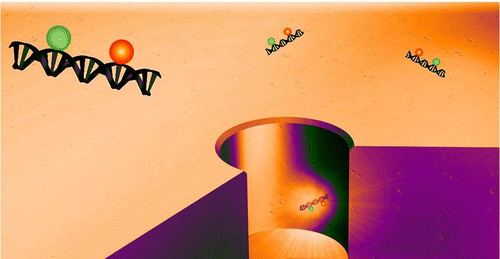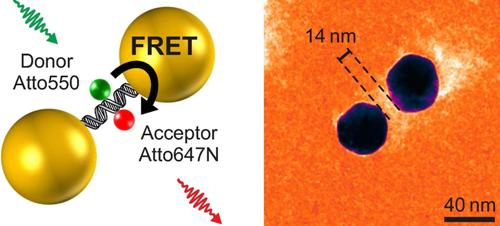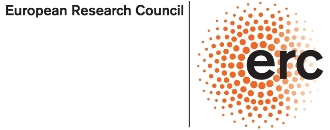Accelerating energy transfer between molecules with optical nanoantennas
Principal investigator : Jerome Wenger
Accueil › L’Institut › Plasmonic enhanced energy transfer
Principal investigator : Jerome Wenger
Energy transfer between molecules is promoted when they are set in an environment that confines light. The energy transfer between molecules is an essential phenomenon for photosynthesis, photovoltaics and biotechnology. Now, thanks to the work of the Institut Fresnel Institute, energy transfer between molecules can be controlled and enhanced with optical structures etched at the nanoscale.
We prepared pairs of energy donor and acceptor molecules linked by rigid double stranded DNA. These pairs were then inserted into nanoapertures and nanoantennas milled in a metallic films with nanoscale dimensions. By accurately measuring the radiation properties of pairs of molecules, the researchers were able to demonstrate that the rate of energy transfer between molecules can be up to 8 times greater when the FRET pair is placed in a well-designed nanophotonic environment.Nanoantennas can also allow FRET even for perpendicularly oriented donor and acceptor pairs. This provides a new strategy using nanophotonics to reveal FRET interactions that would otherwise be impossible to probe with diffraction-limited microscopy.
These promising results are clearing a new path to improve the energy transfer process widely used in life sciences and biotechnology. Optical nanostructures open up many potential applications for biosensors, light sources or photovoltaics.



[8] M. Baibakov, J. Wenger, Laser-induced fluorescence quenching of red fluorescent dyes with green excitation : Avoiding artifacts in PIE-FRET and FCCS analysis, Chem. Phys. Lett. 706, 669-674 (2018). ArXiv 1806.11364
[7] J. de Torres, M. Mivelle, S. B. Moparthi, H. Rigneault, N. F. Van Hulst, M. F. García-Parajó, E. Margeat, J. Wenger, Plasmonic Nanoantennas Enable Forbidden Förster Dipole-Dipole Energy Transfer and Enhance the FRET Efficiency, Nano Lett. 16, 6222-6230 (2016).
[6] S Bidault, A Devilez, P Ghenuche, B Stout, N Bonod, J Wenger, Competition between Förster resonance energy transfer and donor photodynamics in plasmonic dimer nanoantennas, ACS Photonics 3, 895-903 (2016)
[5] J de Torres, P Ferrand, G Colas Des Francs, J Wenger, Coupling Emitters and Silver Nanowires to Achieve Long-Range Plasmon-Mediated Fluorescence Energy Transfer, ACS Nano 10, 3968-3976 (2016).
[4] P. Ghenuche, M. Mivelle, J. de Torres, S. B. Moparthi, H. Rigneault, N. F. Van Hulst, M. F. García-Parajó, J. Wenger, Matching Nanoantenna Field Confinement to FRET Distances Enhances Förster Energy Transfer Rates, Nano Lett 15, 6193-6201 (2015).
[3] J. de Torres, P. Ghenuche, S. B. Moparthi, V. Grigoriev, J. Wenger, FRET Enhancement in Aluminum Zero-Mode Waveguides, Chem. Phys. Chem. 16, 782-788 (2015).
[2] P. Ghenuche, J. de Torres, S. B. Moparthi, V. Grigoriev, J. Wenger, Nanophotonic Enhancement of the Förster Resonance Energy-Transfer Rate with Single Nanoapertures, Nano Lett 14, 4707-4714 (2014).
[1] D. Punj, P. Ghenuche, S. B. Moparthi, J. de Torres, V. Grigoriev, H. Rigneault, J. Wenger, Plasmonic antennas and zero-mode waveguides to enhance single molecule fluorescence detection and fluorescence correlation spectroscopy toward physiological concentrations, WIREs Nanomed Nanobiotechnol 6, 268 (2014).
This project has received funding from the European Research Council under the European Union’s Seventh Framework Programme (FP7/2007-2013) / ERC Grant agreements 278242 (ExtendFRET), and from the Agence Nationale de la Recherche (ANR) under grant agreement ANR-17-CE09-0026-01.
